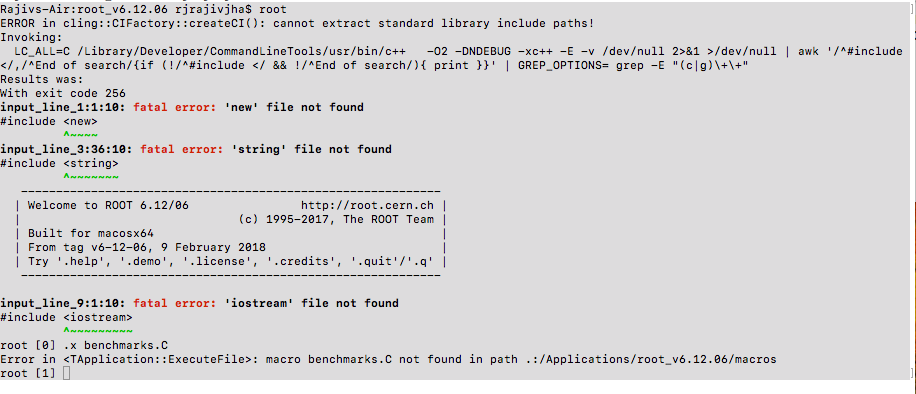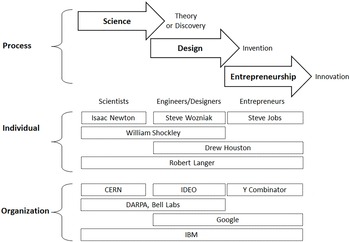30.1 License
Run on CERN LXPLUS; Build from source; ROOT is available on Linux, Mac, and (as a beta release) on Windows. The latest stable ROOT release is 6.24/02 (about ROOT versioning scheme). There are several ways to install ROOT on your computer: they are all listed in the table of content on the right. Run on CERN LXPLUS; Build from source; ROOT is available on Linux, Mac, and (as a beta release) on Windows. The latest stable ROOT release is 6.24/02 (about ROOT versioning scheme). There are several ways to install ROOT on your computer: they are all listed in the table of content on the right.
ROOT is made available under the LGPL v2.1 license. For full details see the file LICENSE in the ROOT distribution.
There are two main methods of installing ROOT from source. 'location independent' is advised for a personal installation of ROOT - 'fixed location' for a system wide installation. Both methods will install ROOT in the location specified as the `CMAKEINSTALLPREFIX` cmake variable at configuration time (`/usr/local` by default).

30.2 Installing ROOT
To install ROOT you will need to go to the ROOT website at: http://root.cern.ch/drupal/content/downloading-root
You have a choice to download the binaries or the source. The source is quicker to transfer since it is only 31 MB, but you will need to compile and link it. The binaries range from 50 MB to 100 MB depending on the target platform.
30.3 Choosing a Version
The ROOT developers follow the principle of “release early and release often”, however a very large portion of a user base requires a stable product therefore generally three versions of the system is available for download - new, old and pro:
The new version evolves quickly, with weekly or bi-weekly releases. Use this to get access to the latest and greatest, but it may not be stable. By trying out the new version you can help us converge quickly to a stable version that can then become the new pro version. If you are a new user we would advice you to try the new version.
The pro (production) version is a version we feel comfortable with to exposing to a large audience for serious work. The change rate of this version is much lower than for the new version, it is about 3 to 6 months.
The old version is the previous pro version that people might need for some time before switching the new pro version. The old change rate is the same as for pro.
30.4 Installing Precompiled Binaries
The binaries are available for downloading from http://root.cern.ch/drupal/content/downloading-root. Once downloaded you need to unzip and de-tar the file. For example, if you have downloaded ROOT v5.30 for Linux-SLC5:
This will create the directory root. Before getting started read the file README/README. Also, read the Introduction chapter for an explanation of the directory structure.
30.5 Installing from the Source
The ROOT’s source code sits in the GitHub repository https://github.com/root-project/root all the details and options to buld ROOT from sources are given in https://root.cern/building-root

In short, the steps to build ROOT from the sources are the following:
- Clone the repository:
- Make a directory for building
- Run cmake and make
- Setup and run ROOT
30.5.0.1 Staying up-to-date
To keep your local ROOT source up-to-date with the GitHub repository you should regularly run the command:
30.6 File system.rootrc
ROOT Environment settings are handled via the class TEnv. gEnv->Print()shows which values are active. Any settings can be obtained by TEnv::GetValue methods that return an integer, double or character value for a named resource. If the resource is not found, the default value (given as the second parameter) is returned.
Via the method TEnv::SetValue allows you can set the value of a resource or create a new resource:
Path used by dynamic loader to find shared libraries and macros. Paths are different for Unix and Windows. The example shows the defaults for all ROOT applications for either Unix or Windows:
Path where to look for TrueType fonts:
Use Net* API functions:
Use thread library (if exists).
Select the compression algorithm (0=old zlib, 1=new zlib). Setting this to `0’ may be a security vulnerability.
Show where item is found in the specified path:
Activate memory statistics.
Global debug mode. When >0 turns on progressively more details debugging.
Settings for X11 behaviour.
Default editor in use.
Default 3d Viewer. By default 3-D views are shown in the pad, if the next line is activated, the default viewer will be OpenGL.
Default Fitter (current choices are Minuit, Minuit2, Fumili and Fumili2).
Specify list of file endings which TTabCom (TAB completion) should ignore.
30.6.1 TCanvas Specific Settings
Opaque move and resize show full pad during the operation instead of only the outline. Especially for resize you will need serious CPU power. UseScreenFactor=true means to size canvas according to size of screen, so a canvas still looks good on a low resolution laptop screen without having to change canvas size in macros.
Hight color 2 is the red one.
Next three settings are related to different user interface parts of canvas window. If they are set to true, the corresponding event status bar, tool bar, graphics editor will be activated by default.
AutoExec allows TExec objects to be executed on mouse and key events.
Canvas print directory is set to the current one by default:
Printer settings:
Default histogram binnings used by TTree::Draw() method.
Default statistics names used for parameters in TPaveStats:
30.6.2 THtml Specific Settings
See the reference guide documentation of THtml class at http://root.cern.ch/root/htmldoc/THtml.html for more details.
XHTML content charset (see http://www.w3.org/TR/2002/REC-xhtml1-20020801, default: ISO-8859-1) is set by:
Stem of a search engine for the documentation, where %s is replaced by the term entered in the search text box (example: http://www.google.com/search?q=%s+site%3Aroot.cern.ch%2Froot%2Fhtml, default is ')
Link to the site’s search engine (default: ', example: http://root.cern.ch/root/Search.phtml)

String to prepend to TClass::GetImplFileName() names containing directories when looking for source files (default: ', example: ../root)
Link stem to ViewCVS entry for classes, where a class name is assumed to match a file name (default: ', example: http://root.cern.ch/viewcvs).
Stem of the CERN XWho system (default: http://consult.cern.ch/xwho/people?)
If set to Doc++, allow method documentation in front of method even for methods in the source file (default: ')
Search path for the source and header files with their default settings:
URL stem for ROOT documentation pages (default is ').
Filesystem output directory for generated web pages (default: htmldoc).
Address of the package’s home page (default: http://root.cern.ch):
Location of user defined header and footer files, see http://root.cern.ch/root/html/THtml#conf:header (defaults are ', example: ../header.txt, ../footer.txt):
Tag for detecting class description comments (default value is set below).
Tag for detecting “Author” comment (default value is set below).
Tag for detecting “last updated” comment. THtml uses the current date if this tag is not found in a class source file (default value is set below).
Tag for detecting “Copyright” comment (default value is set below).
30.6.3 GUI Specific Settings
Set the “native” ROOT GUI interface to be used in a ROOT session.
GUI default fonts in use:
Regular background and foreground colors in use:
Selection background and foreground colors in use:
Document background and foreground colors in use:
Tooltip background and foreground colors in use:
Path where all GUI icons in use can be found:
Mime type file setting:
If $(HOME)/.root.mimes does not exists, defaults to this:
30.6.4 TBrowser Settings
Current icon style selection - can be either small, big, list, details:
Current sorting rule applied on the browser objects - can be name, type, size, date:
Root Install Cern Dmg Online
Number of items in a group view:
Show or not hidden items:
Create a thumbnail view after executing the macro (default is yes).
30.6.5 TRint Specific Settings
Rint (interactive ROOT executable) specific alias, logon and logoff macros.
Record ROOT session commands in a given history file (default is $(HOME)/.root_hist). If set to “-”, it turn off the command recording.
Next two lines set the history file size handling. Once HistSize is reached, the last HistSave entries are removed. If HistSize is set to 0, it turns off command recording. Both values can be overridden by environment variable ROOT_HIST=size[:save], where the “:save” part is optional.
Root Install Cern Dmg Software
30.6.6 ACLiC Specific Settings
ACLiC.Linkdef specifies the suffix that will be added to the script name to try to locate a custom linkdef file when generating the dictionary.

The top directory for storing the libraries produced by ACLiC is set by:
The additional include directives for ACLiC compilations are set by:
30.6.7 PROOF Related Variables
Root Install Cern Dmg Windows 7
PROOF debug options.
PROOF GDB hooks allows a debugger to be attached early in the startup phase of proofserv:0 - don’t wait; 1 - master proofserv enters wait loop; 2 - slave proofserv enters wait loop; 3 - any proofserv enters wait loop
On the master to enable the parallel startup of workers using threads set next to “yes” (default is “no”):
30.6.7.1 Server Authentication in TServerSocket
General setting: file with server access rules
Check of host equivalence via /etc/hosts.equiv or $HOME/.rhosts.
Force file opening via TNetFile (TXNetFile) if a hostname is specified in the Url. By default, for local files TFile::Open() invokes directly TFile.
Special cases for the TUrl parser, where the special cases are parsed in a protocol + file part, like rfio:host:/path/file.root, castor:/path/file.root or /alien/path/file.root. In case the file namespace descriptor ends with - the namespace is not a part of the filename. Extend in private .rootrc with a +Url.Special line.
30.6.7.2 PROOF XRD Client Variables
Debug level (if <=0 : none, 1 : low, 2 : medium, 3 : high)
Socket read timeout [in secs: default 10 secs]
The following env vars are handled by TXNetFile and related classes (module netx, libNetx.so).
XNet.ConnectTimeout - maximum time to wait before server’s response on a connect [10 s]
XNet.RequestTimeout - maximum time to wait before considering a read/write failure [60 s]
XNet.ConnectDomainAllowRE - sequence of TRegexp regular expressions separated by a |. A domain is granted access to for the first connection if it matches one of these regexps. Example:
XNet.ConnectDomainDenyRE - sequence of TRegexp regular expressions separated by a |. A domain is denied access to for the first connection if it matches one of these regexps.
XNet.RedirDomainAllowRE - sequence of TRegexp regular expressions separated by a |. A domain is granted access to for a redirection if it matches one of these regexps. Example:
XNet.RedirDomainDenyRE - sequence of TRegexp regular expressions separated by a |. A domain is granted access to for a redirection if it matches one of these regexps.
XNet.MaxRedirectCount - maximum number of redirections from server [default - 255]
XNet.Debug - log verbosity level (0=nothing,1=messages of interest to the user, 2=messages of interest to the developers (includes also user messages), 3=dump of all sent/received data buffers (includes also user and developers messages). [default - 0]
XNet.ReconnectTimeout - sleep-time before going back to the load balancer (or rebouncing to the same failing host) after a read/write error [default - 10s]
XNet.StartGarbageCollectorThread - for test/development purposes. Normally nonzero (true), but as workaround for external causes someone could be interested in not having the garbage collector thread around. [experimental!]
XNet.GoAsynchronous - default is 0. When activated, XTNetFile works in async mode, allowing input buffering and unsolicited responses [experimental!]
XNet.TryConnect - Number of tries connect to a single server before giving up.
XNet.TryConnectServersList - number of connect retries to the whole server list given [default - 240]
XNet.PrintTAG - Print a particular string the developers can choose to quickly recognize the version at run time [default - 0]
Example of custom setting for the Rint application (root.exe). This overrides the default specified above for a generic application. Color 5 is yellow.
30.7 Documentation to Download
The latest ROOT Users Guide
ROOT Reference Guide